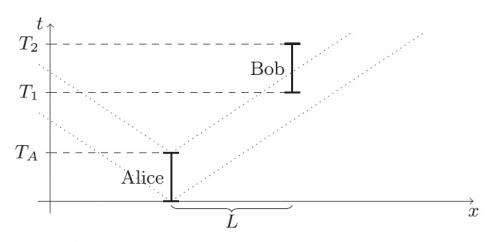March 31, 2015 feature
Photon 'afterglow' could transmit information without transmitting energy
Lisa Zyga
contributing writer

(Â鶹ÒùÔº)—Â鶹ÒùÔºicists have theoretically shown that it is possible to transmit information from one location to another without transmitting energy. Instead of using real photons, which always carry energy, the technique uses a small, newly predicted quantum afterglow of virtual photons that do not need to carry energy. Although no energy is transmitted, the receiver must provide the energy needed to detect the incoming signal—similar to the way that an individual must pay to receive a collect call.
The physicists, Robert H. Jonsson, Eduardo MartÃn-MartÃnez, and Achim Kempf, at the University of Waterloo (MartÃn-MartÃnez and Kempf are also with the Perimeter Institute), have published a paper on the concept in a recent issue of Â鶹ÒùÔºical Review Letters.
Currently, any information transmission protocol also involves energy transmission. This is because these protocols use real photons to transmit information, and all real photons carry energy, so the information and energy are inherently intertwined.
Most of the time when we talk about electromagnetic fields and photons, we are talking about real photons. The light that reaches our eyes, for example, consists only of real photons, which carry both information and energy. However, all electromagnetic fields contain not only real photons, but also virtual photons, which can be thought of as "imprints on the quantum vacuum." The new discovery shows that, in certain circumstances, virtual photons that do not carry energy can be used to transmit information.
The physicists showed how to achieve this energy-less information transmission by doing two things:
"First, we use quantum antennas, i.e., antennas that are in a quantum superposition of states," Kempf told Â鶹ÒùÔº. "For example, with current quantum optics technology, atoms can be used as such antennas. Secondly, we use the fact that, when real photons are emitted (and propagate at the speed of light), the photons leave a small afterglow of virtual photons that propagate slower than light. This afterglow does not carry energy (in contrast to real photons), but it does carry information about the event that generated the light. Receivers can 'tap' into that afterglow, spending energy to recover information about light that passed by a long time ago."
The proposed protocol has another somewhat unusual requirement: it can only take place in spacetimes with dimensions in which virtual photons can travel slower than the speed of light. For instance, the afterglow would not occur in our 3+1 dimensional spacetime if spacetime were completely flat. However, our spacetime does have some curvature, and that makes the afterglow possible.
These ideas also have implications for cosmology. In a paper to be published in a future issue of Â鶹ÒùÔºical Review Letters, MartÃn-MartÃnez and collaborators A. Blasco, L. Garay, and M. Martin-Benito have investigated these implications.
"In that work, it is shown that the afterglow of events that happened in the early Universe carries more information than the light that reaches us from those events," MartÃn-MartÃnez said. "This is surprising because, up until now, it has been believed that real quanta, such as real photons of light, are the only carriers of information from the early Universe."
The new protocol could also have practical applications for quantum communication technology.
"The afterglow also occurs in flat spacetime of dimensions other than 3+1," Jonsson said. "It occurs, in particular, in the case where there is only one spatial dimension, such as is effectively the case in an optical fiber. We are currently investigating applications of our results to quantum communication through optical fibers."
Written for you by our author —this article is the result of careful human work. We rely on readers like you to keep independent science journalism alive. If this reporting matters to you, please consider a (especially monthly). You'll get an ad-free account as a thank-you.
More information: Robert H. Jonsson, et al. "Information Transmission Without Energy Exchange." Â鶹ÒùÔºical Review Letters. DOI:
Journal information: Â鶹ÒùÔºical Review Letters
© 2015 Â鶹ÒùÔº




















